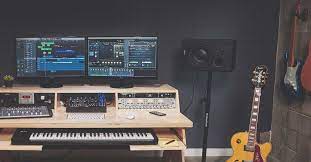Starting your home studio is an exciting prospect, but the reality can be daunting. Setting up a mixing desk, buying equipment, and keeping everything together in one place can be challenging. However, with the right tools and advice from experts, like the ones at Tunemonk, you’ll soon be creating music like a pro. Here’s how.
Planning Your Space
Like any other form of home improvement, setting up your minimalist music studio in your home requires careful planning. It would help if you could determine details such as where you want to place it, how much space it needs, and what features will be necessary for practical use in advance.
This way, all the sounds are balanced properly across both instruments at once. Likewise, you should also get good quality headphones for mixing to have a natural listening experience, whcih will help you to master efficiently.
How To Choose The Right Space For Your Studio
Keep these factors in mind when choosing your studio’s location:
- proximity to electrical outlets and wi-fi signal
- ambient noise level
- room for equipment
Once you have determined which room will become your recording space, think about optimizing it as best as possible. If it has windows, try placing thick curtains or blinds that block light completely.
Choosing The Right Equipment
Choosing what equipment you need to set up your home recording studio is not easy. It would help if you thought about things like how much money you are willing to or are able to spend, whether you will be using high-end equipment, and what style of music you are producing, etc.
For instance, if you are recording hip hop or blues, just an acoustic guitar and microphone might be all that is needed. It’s a good idea to consult professionals like Tunemonk to set up your home studio professionally.
Hardware Considerations
- Synthesizers (virtual or physical)
- Drum machines
- Sequencers
- Samplers
- Vocoders
- Processors and more
Remember: The type of device you use will depend on what genre of music you want to create. You may also need software depending on what kind of production software is used for your studio.
Tips On Setting Up Your Mixing Desk
It’s important to consider what type of desk you’re setting up and how many channels you need. Understand or estimate how much space you must work with. Even if your desk is pack-down, it doesn’t mean that everything must be congested and uncomfortable.
You can work with outlets, distance from speakers, and create more separation between different instrument sections if necessary.
Mixing
For mixing purposes, it may be helpful to put some vocal microphones on one side of your desk facing one way while having your keyboards on another side facing another way. This way, all the sounds are balanced properly across both instruments at once.
Pro Tip: Since you’re new to this, it’s always good to rely on experts’ opinions while setting up your home studio. You can find all the guidance and tips you need online.
Getting To Grips With Your Software
After deciding what kind of system you want to use, the next important decision is which software program to use. As per some of the most experienced professionals, the most important software to consider are:
- Audacity (software)
- Ableton Live (software)
- Logic Pro X
This list of items is just to get you started. You will need to find your way to make it work for you. It’s not that one setup is wrong or right – it’s what works best for you.






MP3quack
Great tips! I love the idea of creating a minimalist music studio. It’s inspiring to see how much you can achieve with just the essentials. I’ll definitely be implementing some of these ideas in my own space. Thanks for sharing!